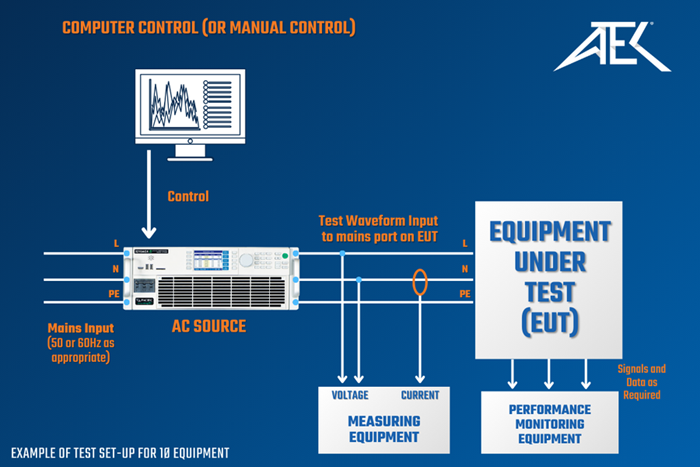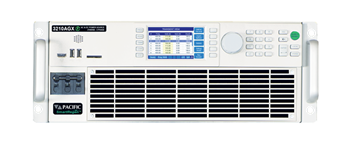What is IEC 61000-4-13: A Practical Guide for Manufacturers
IEC 61000-4-13 is a test standard that defines the immunity test methods and levels for harmonics and interharmonics voltage levels that may be present on low voltage power networks. Essentially, this test measures the immunity of any given device against the presence of such harmonics and interharmonics that are typically caused by non-linear loads such as switch mode power supplies (SMPS) connected to the AC mains.
This standard acts as the common reference for evaluating the functional immunity of electrical and electronic equipment when they are subjected to harmonics and interharmonics superimposed on the mains frequencies. The standard references two distorted waveforms: flat curves (mostly observed in single-phase systems) and overswing curves (mostly observed in three-phase systems). It also defines sweeps of harmonics and interharmonic voltage levels to be applied to the unit under test. Keep reading this blog to learn more about IEC 61000-4-13 and the industries it applies to.
 and electronic equipment with a rated current of <16 A per phase at disturbance frequencies ≤2 kHz (for 50 Hz mains) and ≤2.4 kHz (for 60 Hz mains). The exception for this standard is electrical and electronic equipment that are connected to 16 ⅔ Hz (e.g. railway signaling) or 400 Hz networks (aerospace, defense).
and electronic equipment with a rated current of <16 A per phase at disturbance frequencies ≤2 kHz (for 50 Hz mains) and ≤2.4 kHz (for 60 Hz mains). The exception for this standard is electrical and electronic equipment that are connected to 16 ⅔ Hz (e.g. railway signaling) or 400 Hz networks (aerospace, defense).
Mains signaling and Meister curve levels dictate the immunity test levels for interharmonics above 100 Hz. These levels are defined by section 8.2.4 of this standard and are dependent on the class of equipment being tested. Mains signaling levels range from 2 – 6% of the nominal AC test voltage. Discrete interharmonic frequencies approximately offer 0.5% of the fundamental frequency in the absence of resonance, which can be much higher in class 3 for industrial networks.
For interharmonic waveforms, or waveforms that are not related to this fundamental frequency, specialized controllers, such as those found in Pacific Power Source’s AGX, AFX, and RGS Series power sources, are required to generate these non-harmonic frequencies.
This test can be broken down into a few sections. The programmable AC source is used to generate the variable frequency, amplitude, and phase. This voltage is then applied to the equipment under test while its operating is closely monitored for any abnormal behavior. Also, the load current is measured by the AC source to look for any current resonance points.
.png?lang=en-US&height=467&width=700)
.png?lang=en-US&height=467&width=700)
These transients are generated to measure the response of the DUT to make sure the device functions correctly with no false readings, performance issues, or failures. This must be done in an accredited lab setting to ensure reliable results. The data taken from these tests will then be monitored and recorded to identify problems in case additional testing is required.
This reliability is important, especially for electronic devices sensitive to rapid voltage variations. Fast transient overshoots that go beyond what the machine can tolerate will lead to functional failures. Most modern devices have components that are sensitive to these transients, which is why it is important to test them to make sure they can function properly when put under stressful conditions.
sensitive to rapid voltage variations. Fast transient overshoots that go beyond what the machine can tolerate will lead to functional failures. Most modern devices have components that are sensitive to these transients, which is why it is important to test them to make sure they can function properly when put under stressful conditions.
Additionally, IEC/EN 61000-4-13 compliance is important for gaining market access in many countries, such as the EU, Britain, and many countries in Asia. Some markets, notably the EU, develop their regulations to match IEC standards to ensure a certain level of quality in devices before they are sold to the market. In fact, CE Marks are required for any country in the European Economic Area (EEA) to verify certain products are safe for sale and use.
This standard acts as the common reference for evaluating the functional immunity of electrical and electronic equipment when they are subjected to harmonics and interharmonics superimposed on the mains frequencies. The standard references two distorted waveforms: flat curves (mostly observed in single-phase systems) and overswing curves (mostly observed in three-phase systems). It also defines sweeps of harmonics and interharmonic voltage levels to be applied to the unit under test. Keep reading this blog to learn more about IEC 61000-4-13 and the industries it applies to.
Specifications Associated with IEC 61000-4-13
IEC 61000-4-13 targets electrical and electronic equipment with a rated current of <16 A per phase at disturbance frequencies ≤2 kHz (for 50 Hz mains) and ≤2.4 kHz (for 60 Hz mains). The exception for this standard is electrical and electronic equipment that are connected to 16 ⅔ Hz (e.g. railway signaling) or 400 Hz networks (aerospace, defense).
and electronic equipment with a rated current of <16 A per phase at disturbance frequencies ≤2 kHz (for 50 Hz mains) and ≤2.4 kHz (for 60 Hz mains). The exception for this standard is electrical and electronic equipment that are connected to 16 ⅔ Hz (e.g. railway signaling) or 400 Hz networks (aerospace, defense).Mains signaling and Meister curve levels dictate the immunity test levels for interharmonics above 100 Hz. These levels are defined by section 8.2.4 of this standard and are dependent on the class of equipment being tested. Mains signaling levels range from 2 – 6% of the nominal AC test voltage. Discrete interharmonic frequencies approximately offer 0.5% of the fundamental frequency in the absence of resonance, which can be much higher in class 3 for industrial networks.
Where is IEC 61000-4-13 Applicable?
The levels noted in this test are designed for commercial, residential, and light industrial environments. This means they will typically apply to electrical environments that target commercialized areas such as public utility power grids. However, that is not the only place this standard is applicable, as IEC 61000-4-13 is also vital for product design in industries such as:- Aerospace and/or military (for 50/60Hz applications)
- R&D
- Industrial manufacturing
How to Perform an IEC 61000-4-13 Test
First things first, you will need a programmable AC power source or grid simulator with both harmonics and interharmonics generation capabilities. There are a couple of ways to perform this test depending on the DUT. Some programmable AC sources can generate harmonics by using arbitrary waveforms to create a consistent frequency of 50 or 60Hz. However, interharmonics cannot be generated using arbitrary waveforms and higher order harmonics created using arbitrary waveforms may be attenuated if the AC source has insufficient bandwidth.For interharmonic waveforms, or waveforms that are not related to this fundamental frequency, specialized controllers, such as those found in Pacific Power Source’s AGX, AFX, and RGS Series power sources, are required to generate these non-harmonic frequencies.
This test can be broken down into a few sections. The programmable AC source is used to generate the variable frequency, amplitude, and phase. This voltage is then applied to the equipment under test while its operating is closely monitored for any abnormal behavior. Also, the load current is measured by the AC source to look for any current resonance points.
.png?lang=en-US&height=467&width=700)
.png?lang=en-US&height=467&width=700)
These transients are generated to measure the response of the DUT to make sure the device functions correctly with no false readings, performance issues, or failures. This must be done in an accredited lab setting to ensure reliable results. The data taken from these tests will then be monitored and recorded to identify problems in case additional testing is required.
Why is it Important to Comply with IEC/EN 61000-4-13?
Complying with IEC/EN 61000-4-13 is important for multiple reasons. The most obvious reason is that achieving compliance demonstrates the manufacturer has a strong commitment to quality and reliability for their products, regardless of whether it is for consumer or industrial purposes.This reliability is important, especially for electronic devices
 sensitive to rapid voltage variations. Fast transient overshoots that go beyond what the machine can tolerate will lead to functional failures. Most modern devices have components that are sensitive to these transients, which is why it is important to test them to make sure they can function properly when put under stressful conditions.
sensitive to rapid voltage variations. Fast transient overshoots that go beyond what the machine can tolerate will lead to functional failures. Most modern devices have components that are sensitive to these transients, which is why it is important to test them to make sure they can function properly when put under stressful conditions.Additionally, IEC/EN 61000-4-13 compliance is important for gaining market access in many countries, such as the EU, Britain, and many countries in Asia. Some markets, notably the EU, develop their regulations to match IEC standards to ensure a certain level of quality in devices before they are sold to the market. In fact, CE Marks are required for any country in the European Economic Area (EEA) to verify certain products are safe for sale and use.
How ATEC Can Help You
ATEC rents a variety of programmable AC power sources and grid simulators from leading manufacturers such as Pacific Power Source. A few examples of these products include:- Pacific Power 3210AGX | AC & DC Load/Power Supply | 21kVA (6kVA – 198kVA range when racked with 3210RGS-4C)
- Pacific Power 3210RGS-4C Regenerative Grid Simulator (6kVA – 198kVA range when racked with 3210AGX)
Posted August 18, 2025

.png?lang=en-US&height=144&width=350)
